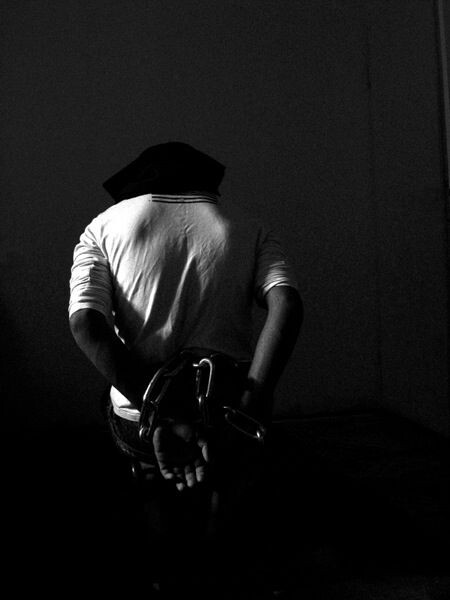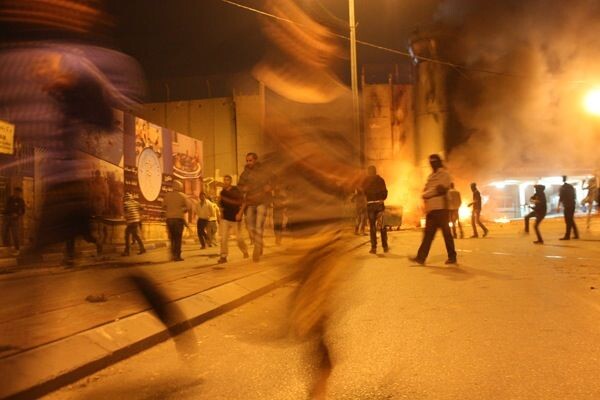The Electronic Intifada Bethlehem 20 January 2014

The photographer experienced Israeli arrest and violence first hand.
Mohammad al-Azza pointed to his right cheek, where an Israeli rubber bullet hit his face, breaking many bones. Only six months after he was shot, the scars were miraculously hard to see.
“The space between the soldiers and me was ten meters,” the Palestinian photographer and filmmaker said. “One of them shouted at me and I didn’t hear him, so I took the camera down and asked him what he said. ‘Don’t take pictures and go inside.’ Usually I don’t listen to them … but this time, I didn’t argue, I just said ‘okay.’ I closed the window and went to close the door of the balcony, and as I was trying to close it I saw a flash, moved my face to the left and was shot through here.”
The 23-year-old Palestinian is from the Aida refugee camp near Bethlehem.
This camp hosts the Lajee Cultural Center, where al-Azza began his explorations in photography in 2005, at the age of 15. Soon after he began, Mohammad realized that photography could be his form of resistance to the occupation.
“Before 2005, which is the time they started building the wall, every day I would go with my friends and we would throw stones. And my friend was shot and killed during this time also. When I threw stones at the army, I feel that I was doing something for Palestine.”
“But after I began taking pictures, I said, ‘Okay, I don’t want to throw stones, I want to learn how to take pictures and make films’ … We need people to throw stones and we need people doing other things to resist the occupation.”
“Before I started, especially in the camp, no one knew how to take photos or make films,” he continued.
“At the same time, as you know, the Israeli and international media is more powerful than the Palestinian media — they talk about Palestine in a certain way and don’t give a clear image of our life. So I decided it is the time for us to talk about ourselves, to show the people out of Palestine the truth of what’s happening. So that’s my reason for taking pictures and making films.”
Self-taught
As a young, largely self-taught media maker, al-Azza has created a large body of work focusing on life in Palestine and especially in Aida camp. His photographs and films have been shown internationally, spreading a glimpse of life in Palestine from Palestinian eyes.
The Electronic Intifada caught up with al-Azza in Boston in October, where his photographs were on display at Tufts University and his film Just A Child was screened at the Boston Palestine Film Festival.
Just a Child is a heartwarming short documentary film about the arrest and release of a 14-year-old Palestinian boy, Raghad. The film captures the nine-month wait which his family has to endure as Raghad’s release continues to be delayed.
His mother tearfully shows us his empty bed and the closet she kept neatly organized, explaining that “The most important thing is for him to have his school materials ready, because he loves school.”
In the film, we witness Raghad’s joyful release and return home. Raghad later describes to the camera that before his arrest, he ran into a “sensitive” area near an Israeli military checkpoint out of fear and confusion, where he was beaten and arrested.
He feels the impacts of prison after his release, saying, “I don’t like going out, I like staying in my room.” Despite this, Raghad participates in protests in solidarity with Palestinian prisoners after his release.
The film was finished in 2011, and al-Azza and Raghad unexpectedly met again a year later in unfortunate conditions. Raghad, a victim of Israel’s cyclical process of arrest and interrogation, would be back in Israeli prison, and al-Azza would be experiencing his first arrest and imprisonment.
Al-Azza was shot in April 2013 while filming Israeli soldiers as they fired tear gas into Aida camp. Following 17 days in hospital, where he underwent two operations, he spent his first night after discharge in his uncle’s home. That night, the Israeli military raided his own home, searching for him.
“They beat my family”
“They started questioning my brothers and my family, asking, ‘Where is Mohammad?’ At that time I wasn’t ready to be arrested because I was still healing,” al-Azza explained.
“So I didn’t stay at my home for two months. Every day I slept in a different house in Bethlehem until I started to feel better. So the first day I was back home — after two months — they came back to my home and arrested me.”
“They found me, and they beat most of my family. There were so many, maybe 100 soldiers [and] dogs. So they found me and they hit me, they started beating me after they hit all of my family. More than one soldier was hitting me, with guns, with hands. I remember telling them, ‘Hit me wherever you want, but not where I’m hurt, not in my face.’ When they heard that, they continued hitting me, this time in my face.”
Al-Azza was arrested because the military believed he had images and video of the protests in the camp. When he heard this, he laughed, and replied, “I’m a journalist, I have a card for it, so I’m not doing something wrong. What is the problem?”
He was kept in jail for 11 days without charge, and there he was briefly reconnected with Raghad.
“There are different rooms for children in jail, and rooms for people who are 18 and up. When they took me for interrogation, you could see the other rooms. I saw someone waving at me, but didn’t recognize him; he had longer hair than he did in the film,” al-Azza recalled.
“I started to recognize him, and I couldn’t believe he was there. When I was released and returned home, I asked his family and they said, ‘Yes, they came and arrested him again six months after he was released.’”
“I found out that he had been arrested for the same thing as before, they said he was planning to do something in a sensitive area near the checkpoint. In Palestine, when you turn 15 you get your identity card, so after he got his identity card they came back and arrested him.”
At the time of our interview, al-Azza was not sure if Raghad had been released from his second imprisonment.
“I wasn’t scared”

“Show the people, not just the occupation,” photographer urges younger peers.
Al-Azza works with the Lajee Cultural Center to prepare youth for arrest and interrogation through workshops. In recent months, as arrests of Palestinian children have increased, the center has responded by organizing more workshops.
Al-Azza recalls his own experience at Lajee as a child, performing a play about arrest and interrogation, and how this helped him in his own experience years later. “I started to remember that I had seen this before, and really, it helped me so much. I wasn’t scared.”
Today, al-Azza works as an educator with the Lajee center. The organization runs a youth media magazine called Our Voice, the content for which is generated from workshops with youth aged 13 to 23 in refugee camps around the occupied West Bank. The center hopes that the project will expand to include 11 camps in 2014.
“The most difficult thing I find with [the youth] is when you ask them what they want to take a picture of, they say, ‘occupation,’” al-Azza explained.
“I tell them to try to think there is no occupation, just think about life in the camp. Show the people, not just the occupation.”
Daryl Meador is a graduate student studying media at The New School, who recently lived and volunteered in Nablus. Follow her on Twitter @yalladaryl.





